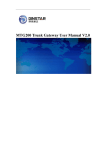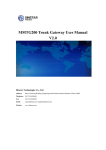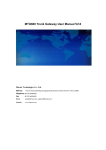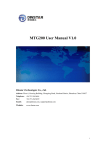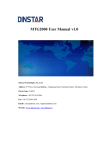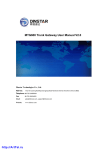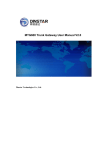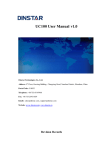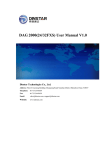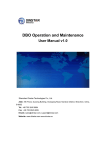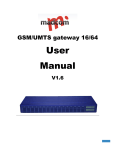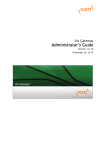Download MTG200 Trunk Gateway User Manual V2.0
Transcript
MTG200 Trunk Gateway User Manual V2.0 Dinstar Technologies Co., Ltd. Address: Floor 6 Guoxing Building Changxing Road Nanshan District Shenzhen China 518052 Telephone: 86-755-26456664 Fax: 86-755-26456659 Email: [email protected], [email protected] Website: www.dinstar.com MTG200 User Manual Revision Records File Name MTG200 User Manual Document Version 2.0 Firmware Version 2.01.01.01 Date 17/04/2012 Revised by Technical Support Department MTG200 User Manual Content 1. PRODUCT INTRODUCTION .............................................................................................................. 1 1.1 Overview ............................................................................................................................. 1 1.2 Equipment Structure............................................................................................................ 2 1.2.1 Rear View ................................................................................................................. 2 1.2.2 Front View ................................................................................................................ 3 1.2.3 RJ-48c Line sequence .............................................................................................. 4 1.3 Functions and Features ........................................................................................................ 4 1.3.1 Protocol standard supported ..................................................................................... 4 1.3.2 System Function ....................................................................................................... 4 1.3.3 Industrial standards supported .................................................................................. 5 1.3.4 General hardware specification ................................................................................ 5 2. PARAMETER SETTING ..................................................................................................................... 6 2.1 Login ................................................................................................................................... 6 2.2 Status &Statistics ................................................................................................................ 7 2.2.1 System Information .................................................................................................. 8 2.2.2 E1/T1 Status ............................................................................................................. 9 2.2.3 PSTN Trunk Status ................................................................................................. 10 2.2.4 IP Trunk Status ....................................................................................................... 10 2.2.5 PRI Call Statistics................................................................................................... 11 2.2.6 SIP Call Statistics ................................................................................................... 12 2.3 Network............................................................................................................................. 12 2.4 PRI Config ........................................................................................................................ 13 2.4.1 PRI Parameter ........................................................................................................ 13 2.4.2 PRI Trunk ............................................................................................................... 14 2.5 PSTN Group Config.......................................................................................................... 15 2.5.1 E1/T1 Parameter..................................................................................................... 15 2.5.2 Coder Group ........................................................................................................... 16 2.5.3 Dial Plan................................................................................................................. 17 2.5.4 Dial Timeout .......................................................................................................... 18 2.5.5 PSTN Profile .......................................................................................................... 18 2.6 SIP Config ......................................................................................................................... 19 2.6.1 SIP Parameter ......................................................................................................... 19 2.6.2 SIP Trunk ............................................................................................................... 20 2.7 IP Group Config ........................................................................................................ 21 2.7.1 IP Profile ................................................................................................................ 21 2.8 Voice & Fax....................................................................................................................... 23 2.9 Maintenance ...................................................................................................................... 24 2.9.1 Management Parameter .......................................................................................... 24 2.9.2 Data Restore ........................................................................................................... 25 MTG200 User Manual 2.9.3 Data Restore ........................................................................................................... 26 2.9.4 Version Information................................................................................................ 26 2.9.5 Firmware Upload ................................................................................................... 26 2.9.6 Password Modification ........................................................................................... 27 2.9.7 Device Restart ........................................................................................................ 27 3.FAQ ............................................................................................................................................... 28 3.1 How to get the IP address if I have modified the default IP or forgot it ? ......................... 28 3.2 Equipment physical connection to normal, but the network cannot be connected or network communication is not normal .................................................................................... 28 3.3 Equipment can’t register................................................................................................. 28 4. GLOSSARY .................................................................................................................................... 29 MTG200 User Manual 1. Product Introduction 1.1 Overview MTG200 is a kind of digital trunk gateway based on embedded operating system, and designed for IPPBX and call center. MTG200 provides 1/2/4*E1/T1 interfaces for users. MTG200 mainly provide E1/T1 interface for small and medium enterprise. It supports rich GUI configuration and 120 road traffic, and the user setting and maintaining system easily. A typical network diagram shows the function of MTG200 as below. Figure 1-1-1 Application topology 1 Dinstar Technologies Co., Ltd. MTG200 User Manual 1.2 Equipment Structure 1.2.1 Rear View Figure 1-2-1 MTG200 Rear View Table 1-2-1 MTG200 Rear View Description Interface Description PWR The power interface. DC12V.1A Port0-Port3 E1/T1 Port. There are 4E1 options. FE0 FE1 The Service Ethernet Interface, standard 10/100BASE-TX Ethernet interfaces. Default IP address is 192.168.1.111,default subnet mask is 255.255.255.0 Management Ethernet Interface. Default IP address is 192.168.11.1, default subnet mask is 255.255.255.0 2 Dinstar Technologies Co., Ltd. MTG200 User Manual 1.2.2 Front View Figure 1-2-2 MTG200 Front View Table 1-2 -2 MTG200 Front View Description LED Function Color POWER Power status indicator Green RUN Register indicator Green ALM RST CONSOLE The failure of device indicator Yellow Work Status Off:Power is off On: Power is on Slow blinking: Unregister Fast blinking: Register Off: Normal On: Failed Reset button, it is used to restart the device RS232 console port: it can be used to debug and configure the device. The baud rate is 115200 bps. Off:E1/T1 port connection normal E1/T1 Indicating the connection state of device E1/T1. Green On: E1/T1 port connection and sending/ receiving message normal Flash:E1/T1 port connection failed LINK Indicating the connection state of the network Off: Network connection failed Green On: Network connection normal, and 0 indicates FE0 and 1 indicates FE1 SPEED Indicating the network bandwidth Yellow Off:10Mbps bandwidth On:100Mbps bandwidth 3 Dinstar Technologies Co., Ltd. MTG200 User Manual 1.2.3 RJ-48c Line sequence MTG200 trunk gateway adopts standard RJ-48C interface and impedance value is 120Ω. Connected end device by cross lines sequence. 1.3 Functions and Features 1.3.1 Protocol standard supported ● Standard SIP /PRI protocol ● Dynamic Host Configuration Protocol (DHCP) ● Point-to-Point Protocol over Ethernet (PPPoE) ● Hypertext Transfer Protocol (HTTP) ● Domain Name System (DNS) ● ITU-T G.711A-Law/U-Law、G.723.1、G.729AB、iLBC (optional) 1.3.2 System Function ● Comfort Noise Generation (CNG) ● Voice Activity Detection (VAD) ● Adaptive (Dynamic) Jitter Buffer (DJB) ● DTMF mode: RFC 2833, SIP INFO and INBAND ● T.38/ Pass-Through FAX over IP ● HTTP/Telnet configuration ● Firmware upgrade by TFTP/Web 4 Dinstar Technologies Co., Ltd. MTG200 User Manual 1.3.3 Industrial standards supported ● Stationary use environment: EN 300 019: Class 3.1 ● Storage environment: EN 300 019: Class 1.2 ● Transportation environment: EN 300 019: Class 2.3 ● Acoustic noise: EN 300 753 ● CE EMC directive 2004/108/EC ● EN55022: 2006+A1:2007 ● EN61000-3-2: 2006, ● EN61000-3-3: 1995+A1: 2001+A2: 2005 ● EN55024: 1998+A1: 2001+A2: 2003 ● Certifications: FCC, CE 1.3.4 General hardware specification ● Power supply: 12VDC, 1A ● Temperature: 0~40℃ (operational),-20~70℃(storage) ● Humidity: 10%~90%, no condensation ● Max power consumption: 15W ● Dimension (mm): 210*150*38 ● Net weight: 0.75kg 5 Dinstar Technologies Co., Ltd. MTG200 User Manual 2. Parameter setting 2.1 Login First, device FE0 port connect PC with string, and then fill FE0 IP address in browser, FE0 default IP address is 192.168.1.111. It will request customer to input user name and password. Default user name and password are “admin”. If customer modified the default IP or forgot the IP, that can’t enter the configuration page. Please connect PC and device serial with the serial line. Enter the CLI to view or modify the equipment IP. Here IP is set to 172.16.33.60. In addition, hold down the RST button to restart the device, customer can regain the port’s default IP. Then enter the IP address of device in the browser address bar. Customer will see the following page. Figure 2-1-1 Login Interfaces The default user name and password is "admin". To guarantee the system safety, when login for the first time. The system will prompt the user to modify the password. The interface is shown as below. Figure 2-1-2 Modify Password After inputting the old password, input a new password and confirm it by inputting it again. 6 Dinstar Technologies Co., Ltd. MTG200 User Manual 2.2 Status &Statistics Users through to traverse the left navigation tree, and can complete view, edit and configuration device in the right configuration interface. MTG configuration flow chart below: 7 Dinstar Technologies Co., Ltd. MTG200 User Manual 2.2.1 System Information This configuration page includes general information and version information. Figure 2-2-1 System Information Table 2-2-1 Description of System Information MAC address Hardware address of FE0 port Service Ethernet Mode Network mode of FE0, include: static and DHCP. Service Ethernet Interface Include: IP address, subnet mask, FE0 port default gateway Management Ethernet Interface Include IP address、subnet mask of FE1 DNS DNS server IP address System Up Time Time elapsed from device power on to now Traffic Statics Total bytes of message received and sent by FE0 port Equipment Type Equipment type; this equipment is: MTG200 Hardware Version Hardware version of device DSP Version Digital signal processing chip driver version Web Version Version of current WEB interface of device Software Version Software version of device running currently Built Time The build time of current software version 8 Dinstar Technologies Co., Ltd. MTG200 User Manual 2.2.2 E1/T1 Status Figure 2-2-2 E1/T1 Status Table 2-2-2 Description of E1/T1 status 1. LOS Alarm: Signal loss alarm, this alarm is created when receiving is lost; please check the physical connection whether disconnected. 2. RAI Alarm: Receive remote alarm indication, it is a signal transmitted in the outgoing direction when a terminal determines that it has lost the incoming signal. Receiving remote alarm indication (RAI) means the far-end equipment over the T1 line has a problem with the signal it is receiving from the upstream equipment. 3. AIS Alarm: The Alarm Indication Signal (AIS) failure is declared when an AIS defect is E1/T1 Port Status detected at the input and the AIS defect still exists after the Loss of frame failure which is caused by the unframed nature of the 'all-ones' signal is declared. The AIS failure is cleared when the Loss Of Frame failure is cleared. 4. Disable: Means that this E1/T1 is not used. 5. ISDN/SS7 Signal Alarm: Means physical connection is normal, signaling link has problem. 6. Active-OK: Means that physical connection and signaling link are normal. 1.Frame-Sync: Non voice channel, which used as a synchronization channel 2.Idle: Means this channel is idle, when the channel is enabled and the cable is connected OK. 3.Signal: Signal channel E1/T1Channel Status 4.Busy: Means this channel is occupied by voice 5. Fault: The channel is enabled but the cable is not connected. 6.Disable: Have not use this E1/T1 trunk 7.L-blocked: Local blocked, means that communication can only be initiated from local 8.R-blocked: 9 Dinstar Technologies Co., Ltd. MTG200 User Manual Remote blocked, means that communication can only be initiated from remote 9.B-blocked: Both Sides blocked, means that the two sides cannot communication 2.2.3 PSTN Trunk Status Figure 2-2-3 PSTN Trunk Status Table 2-2-3 Description of PSTN Trunk Status PRI Trunk No The number of PRI trunk, each trunk corresponds to a PRI link Trunk Name Used to identify the name of the trunk E1/T1Port No Indicate the E1/T1 line occupied by the PRI trunk. Link Status Indicate whether the PRI link is established. 2.2.4 IP Trunk Status Figure 2-2-4 IP Trunk Status Table 2-2-4 Description of IP Trunk Status SIP Trunk No The number of SIP trunk Username When SIP trunk is under registered mode, change the value in the configuration shown in the account registration, If SIP trunk is under non-registered mode, the value is meaningless, as '---' Trunk Mode Peer and Access two modes Register Status Indicate the status of SIP trunk(access mode), register or unregister, when is under peer to peer mode, the values is meaningless, as '---' Link Status Established and Fault status. 10 Dinstar Technologies Co., Ltd. MTG200 User Manual 2.2.5 PRI Call Statistics Figure 2-2-5 PRI Trunk Call Statistics Table 2-2-5 PRI Description of PRI call statistics PRI Trunk No The number of PRI trunk Trunk Name The name used to describe the PRI trunk Current Calls Number of lines that are being called currently Accumulated Calls Total number of calls from running start of system to current time. ASR The percent of calls completed in total calls. This statistics page show the reasons for release of the call, including: Normal Call Clearing, Call Rejected, User Busy, No User Response, No Circuit Available, Unassigned Number, Normal Unspecified and others. Statistical information in an intuitive would be reflected on the pie char. 11 Dinstar Technologies Co., Ltd. MTG200 User Manual 2.2.6 SIP Call Statistics Figure 2-2-6 SIP Trunk Call Statistics Table 2-2-6 Description of SIP Call Statistics SIP Trunk No The number of SIP trunk Trunk Name The name used to describe the PRI trunk Current Calls Number of lines that are being called currently 2.3 Network Figure 2-3-1 Network Configuration 12 Dinstar Technologies Co., Ltd. MTG200 User Manual Table 2-3-1 Description of Network Configuration Obtain IP address Service Ethernet Interface (FE0) If Selected, the MTG will obtain IP address via DHCP automatically Use the following IP If Selected ,Set a static IP for Service Ethernet Interface .Need address to fill the IP address, Subnet Mask, and Default Gateway If users approach the net via PPPoE, please Select it and fill your PPPoE Management account and password. IP address Fill the IP address of FE1 Subnet mask Fill the subnet mask of FE1 Ethernet Interface Obtain DNS server DNS Server If selected, the MTG will obtain DNS server IP address via DHCP address automatically Use the following DNS If selected, you need fill Primary DNS server addresses, the server addresses secondary DNS Server is optional. Ntoe:FE0 port IP and FE1 port IP should be set in different segments. After configure the network address, and restart the gateway configuration to take effect. 2.4 PRI Config 2.4.1 PRI Parameter Figure 2-4-1 PRI Parameter Table 2-4-1 Description of PRI Parameter Provide six plans: Unknown, ISDN/Telephony numbering plan, data Calling Party Numbering Plan numbering plan, telegraph numbering plan, national standard numbering plan, private numbering plan. The default is ISDN/Telephony numbering plan. Calling Party Number Type Six optional types are provided for calling party: Unknown, International 13 Dinstar Technologies Co., Ltd. MTG200 User Manual number, National number, Network special number, User number, Short code dialing. The default option is Unknown. Screening Indicator for Displaying Caller Number Screening Indicator for No Displaying Caller Number Four options available: User provider, no shield; User provide, check and send; User provide, check and having failure; Network provide. The default option is: User provider, no shield. Four options available: User provider, no shield; User provide, check and send; User provide, check and having failure; Network provide. The default option is: User provider, no shield. Provide six plans: Unknown, ISDN/Telephony numbering plan, data Called Party Numbering Plan numbering plan, telegraph numbering plan, national standard numbering plan, private numbering plan. The default is ISDN/Telephony numbering plan. Six optional types are provided for called party: Unknown, International Called Party Number Type number, National number, Network special number, User number, Short code dialing. The default option is Unknown. Information Transfer Capability Support speech and 3.1khz audio. The default option is speech. 2.4.2 PRI Trunk Figure 2-4-2 PRI Trunk Click “Add” to add a PRI Trunk. If user want to delete or modify a PRI Trunk, please select the PRI Trunk user want to do. Figure 2-4-3 PRI Trunk Add 14 Dinstar Technologies Co., Ltd. MTG200 User Manual Table 2-4-2 Description of Add PRI Trunk The number of PRI trunk; when user add PRI trunk, 0~7 number will appear in the pull-down menu to be selected (the number here depends on E1/T1 physical port Trunk No number actually existed in equipment). After trunk number is established, filling in corresponding port number in “E1/T1 Port No.”, so as to assign E1/T1 to designated trunk; Each PRI trunk corresponds to a E1/T1 port. Trunk Name Description of PRI trunk Channel ID Channel ID of E1/T1 ports, this number definition generally starts from 0. D-channel Indicate whether E1/T1 supports D channel, the default is Yes. E1/T1 Port No Protocol E1/T1 port number is numbered according to the physical position of E1/T1, it generally starts from 0. Interface type of PRI. There are two types are available: ISDN and QSIG; the default is ISDN. Indicate PRI network property of E1/T1, it is divided into: “User side” and“Network Switch Side side”. When PRI loopback is carried out, the network properties of E1/T1 port at both receiving and sending sides must be different. Alerting Indication The ring signal include Alerting and Progress 2.5 PSTN Group Config 2.5.1 E1/T1 Parameter Figure 2-5-1 E1/T1 Parameter 15 Dinstar Technologies Co., Ltd. MTG200 User Manual Figure 2-5-2 E1/T1 Parameter Table 2-5-1 Description of Modify E1/T1 Parameter Work Mode E1 or T1, the default is E1 PCM Mode PCM mode: A LAW and Mu LAW, the default is A LAW Frame Mode The frame modes of E1/T1 are: DF, CRC-4, CRC4_ITU, the default is CRC-4; the frame modes of T1 are: F12, F4, ESF, F72, the default is F4 Line Code Line codes of E1/T1 are: NRZ, CMI, AMI, HDB3, the default is HDB3. The line codes of T1 are: NRZ, CMI, AMI, B8ZS, the default is B8ZS Line Built Out Cable length. E1 lines docking, the environment will affect the E1 line signal strength, signal strength according to (DB value) to select the long-term or short-term. 2.5.2 Coder Group Figure 2-5-3 Coder Group 16 Dinstar Technologies Co., Ltd. MTG200 User Manual Table 2-5-2 Description of Coder Group ID standard for Voice ability, total with 8 groups, where 0 is the default group ID Coder Group ID number, the codec that equipment supports in the grouping will be displayed in 0 group. Default value cannot be modified. Coder Support 3 kinds of voice codec: G.711A/U/G.729/G.723 Payload Type Value Each codec has a unique value, refer to RFC3551 Packetization Time(ms) Rate(kbps) Silence Suppression Voice Codec packetization time, user can define different kinds of coding and decoding minimum packetization time. Show the voice data flow rate. It is disabled by default. During talking, the bandwidth occupied by voice transmission will be released automatically for silence party or when talk is paused. 2.5.3 Dial Plan Figure 2-5-4 Dial Plan Dial plan used for configuring the receiving number, user can configure different prefix number, these rules can be divided into 5 groups with a dial plan ID, where 0 is the default setting. Notes: 1. In order to ensure each rule can take effect, long matching numbers (prefix) rule dial plan index value need smaller. 2. Maximum length is 30, this value is the number of the total length and including the prefix length. Click “Add” to add dial plan, configuration page as follow: Table 2-5-3 Description of Dial Plan Dial Plan ID Index Prefix The number to identify a dial plan Dial plan priority rules take effect in accordance with dial plan index size, and not according to the maximum number received. Match number, "." representative of any number The minimum receiving Number length (0 to 30). If receiving a number equal to the minimum length greater than, less than equal to the maximum length, the number will Min Length be used to continue the call. If the maximum length determine the number to receive a complete, will no longer receive a new number, and immediately began to number analysis. If there are numbers continue to be received, the system will give up these numbers. Max Length The largest received number length (0 to 30) 17 Dinstar Technologies Co., Ltd. MTG200 User Manual 2.5.4 Dial Timeout Figure 2-5-4 Dial Timeout Figure 2-5-5 Dial Timeout Add Table 2-5-4 Description Dial Timeout Add Dial Time ID The number to identify a dial timeout rule Description Description of dial timeout Max Time for Collecting Prefix Generally refer to the time from user dial first digit to harvest in prefix number. Time to Reach Min Length(after Prefix) After receiving prefix number, the number has not yet reached the length of the minimum receiving number, the length of timeout Time to Reach Max Length(after Min Length) After receiving number, the number has reached the minimum length, but not reached the maximum length of the dial timeout 2.5.5 PSTN Profile PSTN profile is used to configure PSTN call number rules and parameter. Figure 2-5-6 PSTN Profile 18 Dinstar Technologies Co., Ltd. MTG200 User Manual Figure 2-5-7 PSTN Profile Add Table 2-5-5 Description of Add PSTN Profile PSTN Profile ID The number to PSTN Profile Description Description of the PSTN Profile Code Group ID Refer to "Coder Group" RFC2833 Payload Type The item is 101 by default 1st/2nd/3rd Tx DTMF Option Overlap Receiving There are three ways to send DTMF: RFC2833/SIP INFO/ INBAND, in accordance with the priority choice to send the configuration mode Not enabled by default, only enable this feature, “Dial plan” and “Dial timeout” have the meaning Remove CLI Default does not remove CLI Play busy tone to PSTN Equipment will play busy tone from IP to PSTN 2.6 SIP Config 2.6.1 SIP Parameter Figure 2-6-1 SIP Parameter SIP port number and domain name would be allowed to set to different ports and domain name. 19 Dinstar Technologies Co., Ltd. MTG200 User Manual 2.6.2 SIP Trunk Figure 2-6-2 SIP Trunk Figure 2-6-3 SIP Trunk Add Table 2-6-1 Description of Add SIP Trunk Trunk No The range of trunk number is 0-1 Trunk Name Description the trunk Remote Address IP address of remote SIP platform i Remote Port Q.931 port of SIP of remote platform interfacing with this MTG, the default is 5060 Local Domain Refer to SIP parameter Get Callee from Received the called number from request domain or “To header” filed Register to Remote Defined by IETF work group RFC3372, it is a standard used to establish remote communication between SIP and ISUP; the default is “Yes”; if SIP trunk does not support, then set it to “No”. IP Profile ID Refer to IP Group Config->IP Profile-IP Profile ID 20 Dinstar Technologies Co., Ltd. MTG200 User Manual Incoming SIP Authentication Type There are two modes: IP address and Password. If user selects “password”, then password will be filled. IP to PSTN Call Restriction IP to PSTN side of the limitation on the number of calls; the range is 0~65535, the default is no limitation; If Yes is selected, then input limitation number of calls in the edit box appeared. PSTN to IP Call Restriction PSTN to IP side of the limitation on the number of calls; the range is 0~65535, the default is no limitation; If Yes is selected, then input limitation number of calls in the edit box appeared IP to PSTN Time Restriction The default setting is disabled. If Enabled is selected, then user can edit the start and stop time of prohibition time interval. Within this time interval, all calls from IP to PSTN are prohibited. (Calls from PSTN to IP are not limited) Detect Trunk Status Detect the status of SIP trunk. If select it, the equipment will send HEARTBEAT message to peer to make sure the link status is OK. Enable SIP Trunk A switch used to enable this SIP trunk or not; user can select “Yes” or “No”, when “No” is selected, this SIP trunk is invalid. 2.7 IP Group Config 2.7.1 IP Profile Figure 2-7-1 IP Profile 21 Dinstar Technologies Co., Ltd. MTG200 User Manual Figure 2-7-2 IP Profile Add Table 2-7-1 Description of Add IP Profile IP Profile ID The number to mart the IP Profile Description Description of the PSTN Profile Declare RFC2833 in SDP Support by default Support Early Media Whether support Early Media(183) Ringback Tone to PSTN IP-> PSTN call ring back tone player side, if set to local, it will play from the originated from equipment and set to IP , it will play by the called Ringback Tone to IP originated PSTN->IP call ring back tone player side, if set to local, it will play from the from equipment and set to PSTN, it will play by the called Wait for RTP Packet from Peer T.30 Expanded Type in SDP If set to No, will auto send RTP packets during the call, if set to Yes, will wait the RTP packet was sent by the opposite end first ,then send out RTP packets T30 extended types in SDP: Huawei/ZTE 22 Dinstar Technologies Co., Ltd. MTG200 User Manual 2.8 Voice & Fax Figure 2-8-1 Voice & Fax Configuration Table 2-8-1 Description of Voice & Fax Disconnect Call when no RTP When selected “Yes”, detected call’s silence time packet longer than silence timeout that for a long time not received RTP packets, then hangup the call. Voice Parameter Timeout of no Period without RTP packet The maximum time length of silence PSTN in Gain Incoming PSNT gain IP in Gain Incoming IP gain Call from PSTN Call timeout of no answer from PSTN 23 Dinstar Technologies Co., Ltd. MTG200 User Manual answer Call from IP Call timeout of no answer from IP Two modes are provided: T.38/Pass-through; Fax Mode Fax Parameter Data & Fax Control DTMF Parameter default option is T.38. Fax Tx Gain Gain of sending a fax Fax Rx Gain Gain of receiving a fax Packet time Data packing duration Redundant frame in packet The length of frame in RTP packet Data Whether to allow the control of voice data Fax Whether to allow the control of fax Continuous time The level of a frequency duration Signal interval Threshold for detection The time interval between two different frequency signals Frequency detection threshold 2.9 Maintenance 2.9.1 Management Parameter Figure 2-9-1 Management Parameter 24 Dinstar Technologies Co., Ltd. MTG200 User Manual Table 2-9-1 Description of Management Parameter WEB Port Listening port of local WEB service, the default is 80. Telnet Port Listening port of local Telnet service, the default is 23. Syslog Enable The default is “No”. If select “Yes”, users will set syslog server address and syslog level. Server Address Address for saving system log Syslog Level None, Debug, Notice, Warning, Error. Please choose the file you want to output information level. Send CDR Whether send Call Detail Record through syslog Qos Type There are three options: none, TOS and DS. TOS only supports IPv4. NTP Enable Simple Network Management Protocol is enabled or not; the default is Yes. Primary NTP server The Primary IP address of SNMP management host computer. The host computer of Address the IP address will carry out monitoring and management to equipment. Primary NTP server The port that managed device provides trap message (it is generally alarm message) to Port SNMP management host computer, the default is 123. Secondary NTP server The Secondary IP address of SNMP Address Secondary NTP server The port of the Secondary IP address of SNMP Port Sync Interval Time interval of check Time Zone The time zone of local 2.9.2 Data Restore Figure 2-9-2 Data Backup Table 2-9-2 Description of Data Backup database Click the Backup, and save the database in your PC dialplan Click the Backup, and save the dialplan in your PC exception Click the Backup, and save the exception in your PC 25 Dinstar Technologies Co., Ltd. MTG200 User Manual 2.9.3 Data Restore Figure 2-9-3 Data Restore Table 2-9-3 Description of Data Restore Database Click "Browse" to select the Database file, and then click "Restore". Dialplan Click "Browse" to select the Dialplan file, and then click "Restore". 2.9.4 Version Information Figure 2-9-4 Version Information Here users can view software, database and web version information. 2.9.5 Firmware Upload Figure 2-9-5 Firmware Upload The process of firmware upload: 1)Click “Firmware Upload” 2) Browse files and choose the loading program (Name the file extension. ldf) 3) Click “Upload”, the upload process will last about 60s and device can automatically restart after uploading.(The firmware update process don't shut off the power). 26 Dinstar Technologies Co., Ltd. MTG200 User Manual 2.9.6 Password Modification Figure 2-9-6 Password Modification The configuration items are used to change the login password of web configuration. 2.9.7 Device Restart Figure 2-9-7 Device Restart Some configuration need to restart device to take effect. Click “Restart” to restart the device. 27 Dinstar Technologies Co., Ltd. MTG200 User Manual 3.FAQ 3.1 How to get the IP address if I have modified the default IP or forgot it ? Customers have two ways to get the IP address: 1) Press the RST button, then users can regain default IP. Refer to 1.2.1 Front View 2) Connect the CONSOLE with your PC Serial Port. The baud rate is 115200 bps. The user name is "admin",password is telnet/web login password. If password is reset, the default password is “admin”. When customers have accessed it and input the command "show int" to get the IP. 3.2 Equipment physical connection to normal, but the network cannot be connected or network communication is not normal 1) Make sure the network cable is ok or not , can through view the device WAN port or LAN port indicator light to determine the work states of physical connection 2) Makeing sure the connected network devices (router, switch or hub) support 10M/100M adaptive. Else, connecting the Equipment directly to PC and landing Web , then in the "local connection" .Selecting the correct Ethernet Work Mode 3) Check whether there is a LAN port conflict with the existing IP address 4) Login using the serial port, in the enable mode to view the correct IP and mask, and ping the same segment of the PC or device to see if can pass. 3.3 Equipment can’t register If the Run LED flashes slowly, it means unregistered. 1) Check the network connection is working (see above section), whether the Configuration is Correct. 2) Check whether the LAN firewall setting is inappropriate (such whether limit the network Communication); If it is, there are two ways to try to resolve: 2.1) Ask network administrators to open limitation with the equipment’s network communications (it is a special equipment, not afraid of virus attacks); 2.2) Try to enable the equipment tunnel (Through the WEB for Configuration, Also, please NOTE, open the tunnel will impact voice quality, Please do not enable the tunnel as far as possible, reference WEB Configuration Interface, Description section). 4) Check whether the Local Network to the SIP PROXY platform network environment is relatively poor or not, and if so, please check Local Network or contact the service provider. 5) If go through those steps, the device still be in trouble, please contact the equipment provider. 28 Dinstar Technologies Co., Ltd. MTG200 User Manual 4. Glossary PRI: Primary rate interface DND: Do-not-Disturb FMC: Fixed Mobile Convergence SIP: Session Initiation Protocol DTMF: Dual Tone Multi Frequency USSD: Unstructured Supplementary Service Data PSTN:Public Switched Telephone Network STUN: Simple Traversal of UDP over NAT IVR: Interactive Voice Response IMSI: International Mobile Subscriber Identification Number IMEI: International Mobile Equipment Identity DMZ: Demilitarized Zone 29 Dinstar Technologies Co., Ltd.

































